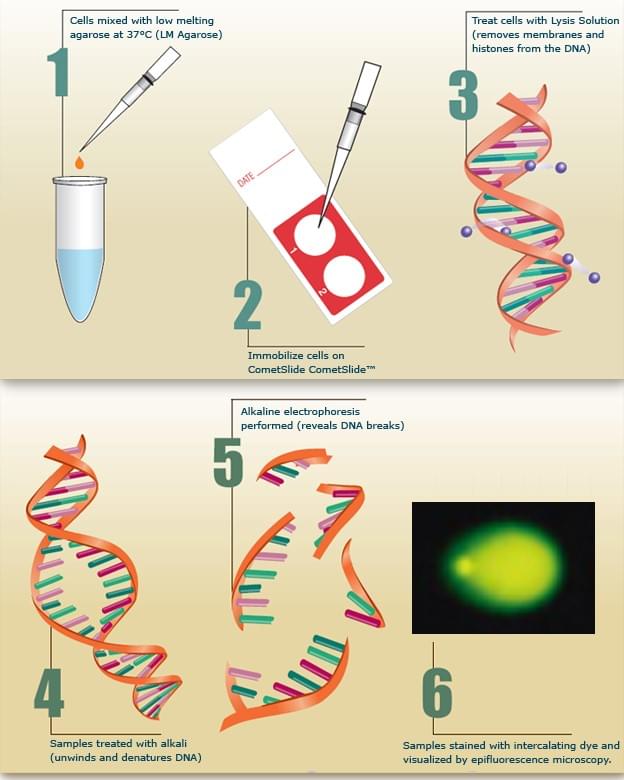- You are here: Home
- Services
- Drug Toxicity Services
- In Vitro Genotoxicity
- In Vitro Comet Assay
Services
-
Cell Services
- Cell Line Authentication
- Cell Surface Marker Validation Service
-
Cell Line Testing and Assays
- Toxicology Assay
- Drug-Resistant Cell Models
- Cell Viability Assays
- Cell Proliferation Assays
- Cell Migration Assays
- Soft Agar Colony Formation Assay Service
- SRB Assay
- Cell Apoptosis Assays
- Cell Cycle Assays
- Cell Angiogenesis Assays
- DNA/RNA Extraction
- Custom Cell & Tissue Lysate Service
- Cellular Phosphorylation Assays
- Stability Testing
- Sterility Testing
- Endotoxin Detection and Removal
- Phagocytosis Assays
- Cell-Based Screening and Profiling Services
- 3D-Based Services
- Custom Cell Services
- Cell-based LNP Evaluation
-
Stem Cell Research
- iPSC Generation
- iPSC Characterization
-
iPSC Differentiation
- Neural Stem Cells Differentiation Service from iPSC
- Astrocyte Differentiation Service from iPSC
- Retinal Pigment Epithelium (RPE) Differentiation Service from iPSC
- Cardiomyocyte Differentiation Service from iPSC
- T Cell, NK Cell Differentiation Service from iPSC
- Hepatocyte Differentiation Service from iPSC
- Beta Cell Differentiation Service from iPSC
- Brain Organoid Differentiation Service from iPSC
- Cardiac Organoid Differentiation Service from iPSC
- Kidney Organoid Differentiation Service from iPSC
- GABAnergic Neuron Differentiation Service from iPSC
- Undifferentiated iPSC Detection
- iPSC Gene Editing
- iPSC Expanding Service
- MSC Services
- Stem Cell Assay Development and Screening
- Cell Immortalization
-
ISH/FISH Services
- In Situ Hybridization (ISH) & RNAscope Service
- Fluorescent In Situ Hybridization
- FISH Probe Design, Synthesis and Testing Service
-
FISH Applications
- Multicolor FISH (M-FISH) Analysis
- Chromosome Analysis of ES and iPS Cells
- RNA FISH in Plant Service
- Mouse Model and PDX Analysis (FISH)
- Cell Transplantation Analysis (FISH)
- In Situ Detection of CAR-T Cells & Oncolytic Viruses
- CAR-T/CAR-NK Target Assessment Service (ISH)
- ImmunoFISH Analysis (FISH+IHC)
- Splice Variant Analysis (FISH)
- Telomere Length Analysis (Q-FISH)
- Telomere Length Analysis (qPCR assay)
- FISH Analysis of Microorganisms
- Neoplasms FISH Analysis
- CARD-FISH for Environmental Microorganisms (FISH)
- FISH Quality Control Services
- QuantiGene Plex Assay
- Circulating Tumor Cell (CTC) FISH
- mtRNA Analysis (FISH)
- In Situ Detection of Chemokines/Cytokines
- In Situ Detection of Virus
- Transgene Mapping (FISH)
- Transgene Mapping (Locus Amplification & Sequencing)
- Stable Cell Line Genetic Stability Testing
- Genetic Stability Testing (Locus Amplification & Sequencing + ddPCR)
- Clonality Analysis Service (FISH)
- Karyotyping (G-banded) Service
- Animal Chromosome Analysis (G-banded) Service
- I-FISH Service
- AAV Biodistribution Analysis (RNA ISH)
- Molecular Karyotyping (aCGH)
- Droplet Digital PCR (ddPCR) Service
- Digital ISH Image Quantification and Statistical Analysis
- SCE (Sister Chromatid Exchange) Analysis
- Biosample Services
- Histology Services
- Exosome Research Services
- In Vitro DMPK Services
-
In Vivo DMPK Services
- Pharmacokinetic and Toxicokinetic
- PK/PD Biomarker Analysis
- Bioavailability and Bioequivalence
- Bioanalytical Package
- Metabolite Profiling and Identification
- In Vivo Toxicity Study
- Mass Balance, Excretion and Expired Air Collection
- Administration Routes and Biofluid Sampling
- Quantitative Tissue Distribution
- Target Tissue Exposure
- In Vivo Blood-Brain-Barrier Assay
- Drug Toxicity Services
In Vitro Comet Assay
Creative Bioarray is currently offering in vitro comet assay for rapid genotoxicity assessment by detecting DNA damage in the form of double strand breaks, single strand breaks, alkali labile sites, oxidative base damage, and DNA-DNA or DNA-protein crosslinking.
Comet assay, also known as single cell gel electrophoresis (SCGE) assay, is a rapid, sensitive, and relatively simple method for detecting DNA damage in individual eukaryote cells. This assay is sensitive to damage of about 50 to 10,000 breaks per diploid mammalian cell.
In this assay, cells are treated with test compounds at different concentrations for a few hours and then embedded in agarose microgels on microscope slides. Lysis solution is applied to the slides to lyse the cells and remove cellular proteins. The DNA is then allowed to unwind under alkaline or neutral conditions for appropriate length of time before undergoing Electrophoresis. The broken DNA fragments or damaged DNA migrate away from the nucleus and give out a comet-like appearance after staining with a DNA-specific fluorescent dye with the head being the intact DNA and the tail being damaged DNA fragments.
Stained slides are observed by fluorescence microscopy. The length and the intensity of the comet tail relative to the head reflects the extent and amount of DNA damage. Up to 50 comets per concentration will be analyzed by imaging software to assess the genotoxicity of test compounds.

Fig. Comet Assay Procedure. (1, Mix cells with low melting agarose; 2, Immobilize cells on a slide; 3, Remove cellular proteins with lysis solution; 4, Unwind and denature DNA; 5, Electrophoresis; 6, Stain with fluorescent dyes and image)
Advantages:
• Allow custom assay design
• Both alkaline and neutral conditions available
• State-of-the-art image analysis
• Well-set quality control
• High performance
• Cheap and fast
• Applicable on many cell types
Staffed with a group of experts in genotoxicity, Creative Bioarray can provide you with the best service in the field. Please feel free to contact us for more information, or require a quote by filling in the chart below. Our support team will contact you and help you with your request.
Explore Other Options
For research use only. Not for any other purpose.

